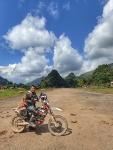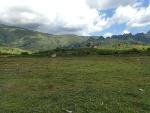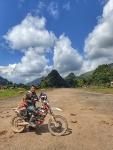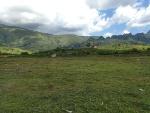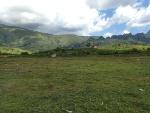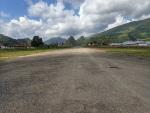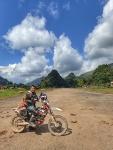Long Cheng (tieng) Ls 20a
- Thread starter brian_bkk
- Start date
You are using an out of date browser. It may not display this or other websites correctly.
You should upgrade or use an alternative browser.
You should upgrade or use an alternative browser.
Speaking with a well connected local in phonsavan that asked not to be quoted.
The new road to long cheng being built by the current contractor will be asphalt and finish at the border with Vientiane province.
A Chinese contractor will build the road from there..
" It will be a highway "
So looks like you road bikers will also be able to visit Long Chieng in the future.
Cheers
Brian
The new road to long cheng being built by the current contractor will be asphalt and finish at the border with Vientiane province.
A Chinese contractor will build the road from there..
" It will be a highway "
So looks like you road bikers will also be able to visit Long Chieng in the future.
Cheers
Brian
Three of us Malaysians made it to LS20A on 16/11/2015 riding our dirt bikes from Xaysamboun - Long Cheng - Phonsavan and no ... the dog did not make it.




Attachments
Congratulations - I bet that really felt like being on top of the world. Well done.rob7711 wrote:
Three of us Malaysians made it to LS20A on 16/11/2015 riding our dirt bikes from Xaysamboun – Long Cheng – Phonsavan and no … the dog did not make it.



Attachments
Well done.. Great ride isn't it.rob7711 wrote:
Three of us Malaysians made it to LS20A on 16/11/2015 riding our dirt bikes from Xaysamboun – Long Cheng – Phonsavan and no … the dog did not make it.



Cheers
Brian
Attachments
Came across this picture of long cheng today. Clearest one yet.
Cheers
Brian
Remembering the Courage of the CIA’s Friends
Remembering the Courage of the CIA’s Friends
A new film honors a legacy that Obama overlooked during his visit to Laos last week.
By
Jack Jolis
Sept. 12, 2016 1:25 p.m. ET
2 COMMENTS
Barack Obama last week became the first sitting U.S. President to visit Laos. Promising to “continue to deal with the painful legacy of war,” he announced increased U.S. aid to help Laos clear unexploded munitions from the so-called “secret war” of 1962-75. Having served as a CIA case officer in Laos in 1970, I know something about that legacy—particularly the bits that went unmentioned by Mr. Obama.
My own thoughts are with our most loyal and dedicated allies from that era, the dwindling Hmong of northern Laos, for whom the war never ended. A small population of Hmong persist today in their ancestral mountains of Xieng Khouang, waging a desperate struggle against the Laotian government’s punitive war of extermination. Their conflict now isn’t so much “secret” as forgotten or ignored, at least by the U.S. and other outside powers.
For centuries the Hmong have been fighting off encroaching foreigners—whether Lao, Chinese or Vietnamese. They were enthusiastic partners 40 years ago for U.S. officers seeking intelligence on the 40,000 to 60,000 North Vietnamese soldiers who, at any given time, illegally used Laos as a staging area and conduit to South Vietnam. As part of what was then the Royal Lao Army, the Hmong were invaluable to U.S. efforts to interdict and harass the invading North Vietnamese.
 ENLARGE
ENLARGE
From the documentary “Clandestino: The Lost Army of the CIA.” Photo: Sergio Caro
Most of these brave Hmong were captured or killed following the U.S. withdrawal. In 1975 the Royal Kingdom of Laos became the “Lao People’s Democratic Republic,” which proceeded to rape, murder or torture more than 100,000 Hmong regardless of whether they were “guilty” of having helped the Americans. The lucky ones fled through Thailand to California, Minnesota and Wisconsin. By the 1990s, fewer than 10,000 remained in Laos and, as of 2016, perhaps 100 are still fighting.
These few maintain a threadbare guerrilla resistance against the genocidal policies of the communist government in Vientiane—the same regime that wined and dined Mr. Obama last week. Mr. Obama’s speech only mentioned the Hmong as part of “Laos’s tapestry of proud ethnic groups and indigenous peoples.” He is likely unaware of the dramatic reality in those mountains. The Laotian military restricts access to the area, often with landmines that are more reactive than unexploded U.S. ordinance.
An intrepid Spanish documentary film crew led by David Beriain recently undertook the fraught and dangerous mission of locating the doughty Hmong in northern Laos. The result is “Clandestino: The Lost Army of the CIA,” produced by 93Metros y 7yAccion in conjuction with The Discovery Channel. The film has screened in Europe and is now in negotiation for U.S. release.
The documentary traces the crew’s journey from Hmong exile groups in Minnesota, through the back alleys of Udon Thani in Thailand, and to the Laotian border, where they posed as tourists to enter the country. From there, the team trekked for two weeks to find the secret and constantly moving Hmong encampment. The regime in Vientiane calls these Hmong “insurgents,” but Mr. Beriain’s extraordinary footage shows that the handful of men, women and children are just fighting to survive.
“I was 9 years old,” an adolescent boy tells Mr. Beriain, recalling his first firefight. “They shot my grandpa, and I picked up his gun and started shooting.”
The Hmong suffer most of their casualties when venturing to find food. In one scene, a 20-year-old mother shows Mr. Beriain the scar on her arm from the day Laotian soldiers attacked while she cooked roots for her children.
The film highlights a few returned exiles among the Hmong resistance who snuck back into Laos from their refuges in America. Most of the film’s subjects are descendants of the Hmong who worked with the CIA decades ago. Combatants by birth, they have effectively been trapped and besieged their whole lives.
“Have you considered surrendering?” Mr. Beriain asks one Hmong man, who is no older than 40 and riddled with bullet wounds. “My nephew turned himself in,” replies the man. “The Lao Army killed him, so we can’t give up.”
Because I appear briefly in the film, I was invited to the opening in Madrid in May. Spanish press wanted to know what effect I hoped the documentary would have on the tragic situation in northern Laos.
No happy outcome seems possible under current conditions: The Laotian regime won’t tolerate the independent existence of a minority outside its totalitarian control, and the Hmong imperative to maintain their way of life seems inextinguishable. The Hmong have made repeated pleas to the United Nations for help, with little to show for it.
The best anyone can hope for is that enough people will see this film to bring moral pressure on Vientiane for a humane modus vivendi. The Hmong who survive in northern Laos are the living legacy of the “secret war,” and they want only to be left in peace. I salute the producers of “The Lost Army of the CIA” for making such an outcome more likely, however remote it remains.
Mr. Jolis was a U.S. Army officer in Vietnam in 1968-69 and a CIA officer with the Hmong in northern Laos in 1970.
Remembering the Courage of the CIA’s Friends
A new film honors a legacy that Obama overlooked during his visit to Laos last week.
By
Jack Jolis
Sept. 12, 2016 1:25 p.m. ET
2 COMMENTS
Barack Obama last week became the first sitting U.S. President to visit Laos. Promising to “continue to deal with the painful legacy of war,” he announced increased U.S. aid to help Laos clear unexploded munitions from the so-called “secret war” of 1962-75. Having served as a CIA case officer in Laos in 1970, I know something about that legacy—particularly the bits that went unmentioned by Mr. Obama.
My own thoughts are with our most loyal and dedicated allies from that era, the dwindling Hmong of northern Laos, for whom the war never ended. A small population of Hmong persist today in their ancestral mountains of Xieng Khouang, waging a desperate struggle against the Laotian government’s punitive war of extermination. Their conflict now isn’t so much “secret” as forgotten or ignored, at least by the U.S. and other outside powers.
For centuries the Hmong have been fighting off encroaching foreigners—whether Lao, Chinese or Vietnamese. They were enthusiastic partners 40 years ago for U.S. officers seeking intelligence on the 40,000 to 60,000 North Vietnamese soldiers who, at any given time, illegally used Laos as a staging area and conduit to South Vietnam. As part of what was then the Royal Lao Army, the Hmong were invaluable to U.S. efforts to interdict and harass the invading North Vietnamese.
From the documentary “Clandestino: The Lost Army of the CIA.” Photo: Sergio Caro
Most of these brave Hmong were captured or killed following the U.S. withdrawal. In 1975 the Royal Kingdom of Laos became the “Lao People’s Democratic Republic,” which proceeded to rape, murder or torture more than 100,000 Hmong regardless of whether they were “guilty” of having helped the Americans. The lucky ones fled through Thailand to California, Minnesota and Wisconsin. By the 1990s, fewer than 10,000 remained in Laos and, as of 2016, perhaps 100 are still fighting.
These few maintain a threadbare guerrilla resistance against the genocidal policies of the communist government in Vientiane—the same regime that wined and dined Mr. Obama last week. Mr. Obama’s speech only mentioned the Hmong as part of “Laos’s tapestry of proud ethnic groups and indigenous peoples.” He is likely unaware of the dramatic reality in those mountains. The Laotian military restricts access to the area, often with landmines that are more reactive than unexploded U.S. ordinance.
An intrepid Spanish documentary film crew led by David Beriain recently undertook the fraught and dangerous mission of locating the doughty Hmong in northern Laos. The result is “Clandestino: The Lost Army of the CIA,” produced by 93Metros y 7yAccion in conjuction with The Discovery Channel. The film has screened in Europe and is now in negotiation for U.S. release.
The documentary traces the crew’s journey from Hmong exile groups in Minnesota, through the back alleys of Udon Thani in Thailand, and to the Laotian border, where they posed as tourists to enter the country. From there, the team trekked for two weeks to find the secret and constantly moving Hmong encampment. The regime in Vientiane calls these Hmong “insurgents,” but Mr. Beriain’s extraordinary footage shows that the handful of men, women and children are just fighting to survive.
“I was 9 years old,” an adolescent boy tells Mr. Beriain, recalling his first firefight. “They shot my grandpa, and I picked up his gun and started shooting.”
The Hmong suffer most of their casualties when venturing to find food. In one scene, a 20-year-old mother shows Mr. Beriain the scar on her arm from the day Laotian soldiers attacked while she cooked roots for her children.
The film highlights a few returned exiles among the Hmong resistance who snuck back into Laos from their refuges in America. Most of the film’s subjects are descendants of the Hmong who worked with the CIA decades ago. Combatants by birth, they have effectively been trapped and besieged their whole lives.
“Have you considered surrendering?” Mr. Beriain asks one Hmong man, who is no older than 40 and riddled with bullet wounds. “My nephew turned himself in,” replies the man. “The Lao Army killed him, so we can’t give up.”
Because I appear briefly in the film, I was invited to the opening in Madrid in May. Spanish press wanted to know what effect I hoped the documentary would have on the tragic situation in northern Laos.
No happy outcome seems possible under current conditions: The Laotian regime won’t tolerate the independent existence of a minority outside its totalitarian control, and the Hmong imperative to maintain their way of life seems inextinguishable. The Hmong have made repeated pleas to the United Nations for help, with little to show for it.
The best anyone can hope for is that enough people will see this film to bring moral pressure on Vientiane for a humane modus vivendi. The Hmong who survive in northern Laos are the living legacy of the “secret war,” and they want only to be left in peace. I salute the producers of “The Lost Army of the CIA” for making such an outcome more likely, however remote it remains.
Mr. Jolis was a U.S. Army officer in Vietnam in 1968-69 and a CIA officer with the Hmong in northern Laos in 1970.
Attachments
Clandestino: the Lost Army of the CIA (full documentary)
Clandestino: the Lost Army of the CIA (full documentary) Follow up to our earlier post of the Wall Street Journal post. A new Spanish documentary film crew led by David Beriain recently undertook the fraught and dangerous mission of locating the doughty Hmong in northern Laos. The result is “Clandestino: The Lost Army of the CIA,” produced by 93Metros y 7yAccion in conjuction with The Discovery Channel. The film has screened in Europe and is now in negotiation for U.S. release. You may watch this version that was uploaded on Youtube in June 2016.
Clandestino: the Lost Army of the CIA (full documentary) Follow up to our earlier post of the Wall Street Journal post. A new Spanish documentary film crew led by David Beriain recently undertook the fraught and dangerous mission of locating the doughty Hmong in northern Laos. The result is “Clandestino: The Lost Army of the CIA,” produced by 93Metros y 7yAccion in conjuction with The Discovery Channel. The film has screened in Europe and is now in negotiation for U.S. release. You may watch this version that was uploaded on Youtube in June 2016.

Picture credit. Steve C Canyon (Chris Corbett)
Steve C Canyon from Moto Lao made it in to long chieng this weekend.
Had a visit from the boys in green, paid a fine and was told to be in his room by 9 pm.
So if you want to give it a try.. Looks like long chieng is back open, at least tentatively at this stage
Last edited:
My Friend Mike and I rode in March 2017 from Phonsawan to Nong Khai via Long Chen and riding the famous airstrip(Never heard about it before that day)
It was our last day of 2 weeks travelling in Northern Laos.
A few K's out of Phonsawan we entered the dirt road that lasted for about 180 K's or maybe more,cant remember exactly any more.We hit the main road 13 south of Vang Vieng ,near the big Lake.
This was another ride I will remember....very nice adventure!











It was our last day of 2 weeks travelling in Northern Laos.
A few K's out of Phonsawan we entered the dirt road that lasted for about 180 K's or maybe more,cant remember exactly any more.We hit the main road 13 south of Vang Vieng ,near the big Lake.
This was another ride I will remember....very nice adventure!
Last edited by a moderator:
My Friend Mike and I rode in March 2017 from Phonsawan to Nong Khai via Long Chen and riding the famous airstrip(Never heard about it before that day)
It was our last day of 2 weeks travelling in Northern Laos.
A few K's out of Phonsawan we entered the dirt road that lasted for about 180 K's or maybe more,cant remember exactly any more.We hit the main road 13 south of Vang Vieng ,near the big Lake.
This was another ride I will remember....very nice adventure!
View attachment 118075
View attachment 118076
View attachment 118077
View attachment 118078
View attachment 118079
View attachment 118080
View attachment 118081
View attachment 118082
View attachment 118083
View attachment 118084
View attachment 118085
Bloody hell that would have been some adventure.
Why did you go that way if "via Long Chen and riding the famous airstrip(Never heard about it before that day)".
Because that is well & truly off the beaten track.
I don't do much research, but Mike with whom is was riding together with, knew about the "secret base"....that's why we went that way..... We we're only stopped once on a milletary checkpoint , about 30 k past Long Chen ..but no issues at allBloody hell that would have been some adventure.
Why did you go that way if "via Long Chen and riding the famous airstrip(Never heard about it before that day)".
Because that is well & truly off the beaten track.
That will be great but it's a long way from being completed and will likely take a few years to complete. In the meantime the Adventure is awesome.Speaking with a well connected local in phonsavan that asked not to be quoted.
The new road to long cheng being built by the current contractor will be asphalt and finish at the border with Vientiane province.
A Chinese contractor will build the road from there..
" It will be a highway "
So looks like you road bikers will also be able to visit Long Chieng in the future.
Cheers
Brian
My Friend Mike and I rode in March 2017 from Phonsawan to Nong Khai via Long Chen and riding the famous airstrip(Never heard about it before that day)
It was our last day of 2 weeks travelling in Northern Laos.
A few K's out of Phonsawan we entered the dirt road that lasted for about 180 K's or maybe more,cant remember exactly any more.We hit the main road 13 south of Vang Vieng ,near the big Lake.
This was another ride I will remember....very nice adventure!
View attachment 118075
View attachment 118076
View attachment 118077
View attachment 118078
View attachment 118079
View attachment 118080
View attachment 118081
View attachment 118082
View attachment 118083
View attachment 118084
View attachment 118085
Definitely the Highlight of our 2 weeks in Laos , A beautiful Blue Bird day for riding except the Dust !!!! This is the Real Laos that is being devastated by the indiscrimate cutting of trees heading to China. Laos is still the Wild west and Gery forgot to mention the Local sligging an AK47 on his back on that road, but not threathening us. The views were awesome and the highlight was riding down the Runway !!!
We had no special permits and remember there are limited services on the way.
I ride an NC750X DCT with off road tires, Heideneau at that time and my bike now has 119,500KM in 2 years, Gery Rides a Triumph Tiger with Mitas 07.
Definitely back on the Bucket list and hopefully one night sleeping there in a Guesthouse
Last edited by a moderator:
Definitely the Highlight of our 2 weeks in Laos , A beautiful Blue Bird day for riding except the Dust !!!! This is the Real Laos that is being devastated by the indiscrimate cutting of trees heading to China. Laos is still the Wild west and Gery forgot to mention the Local sligging an AK47 on his back on that road, but not threathening us. The views were awesome and the highlight was riding down the Runway !!!
We had no special permits and remember there are limited services on the way.
I ride an NC750X DCT with off road tires, Heideneau at that time and my bike now has 119,500KM in 2 years, Gery Rides a Triumph Tiger with Mitas 07.
Definitely back on the Bucket list and hopefully one night sleeping there in a Guesthouse
View attachment 118525
View attachment 118526
View attachment 118527
View attachment 118528
View attachment 118529
View attachment 118530
View attachment 118531
View attachment 118532
View attachment 118533
Thanks for the update Mike.
Laos is always awesome to ride - great people, challenging roads & infrastructure that all seem to make it worthwhile & memorable enough to want to keep going back.
If you want to post any of your other rides on GTR you are welcome to do so
Thanks for the update Mike.
Laos is always awesome to ride - great people, challenging roads & infrastructure that all seem to make it worthwhile & memorable enough to want to keep going back.
Any recent updates on Long Cheng???, -I 've been wanting to do a ride up there for the last couple of years......
Another interesting article

 www.bangkokpost.com
www.bangkokpost.com

CIA spook recalls Thailand's role in secret war
A CIA spy who helped orchestrate America's "secret war" in Laos said US President Barack Obama's visit should not dwell on the past as he defended the soldiers he fought beside, including the Thais.



